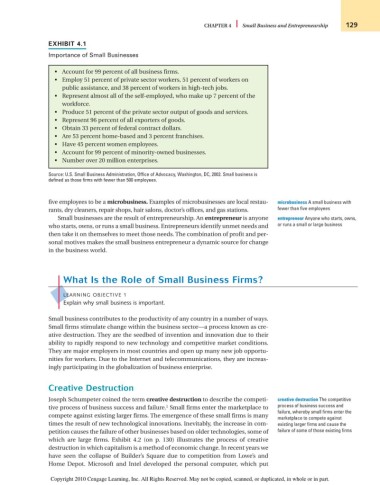Page 155 - Introduction to Business
P. 155
CHAPTER 4 Small Business and Entrepreneurship 129
EXHIBIT 4.1
Importance of Small Businesses
• Account for 99 percent of all business firms.
• Employ 51 percent of private sector workers, 51 percent of workers on
public assistance, and 38 percent of workers in high-tech jobs.
• Represent almost all of the self-employed, who make up 7 percent of the
workforce.
• Produce 51 percent of the private sector output of goods and services.
• Represent 96 percent of all exporters of goods.
• Obtain 33 percent of federal contract dollars.
• Are 53 percent home-based and 3 percent franchises.
• Have 45 percent women employees.
• Account for 99 percent of minority-owned businesses.
• Number over 20 million enterprises.
Source: U.S. Small Business Administration, Office of Advocacy, Washington, DC, 2002. Small business is
defined as those firms with fewer than 500 employees.
five employees to be a microbusiness. Examples of microbusinesses are local restau- microbusiness A small business with
rants, dry cleaners, repair shops, hair salons, doctor’s offices, and gas stations. fewer than five employees
Small businesses are the result of entrepreneurship. An entrepreneur is anyone entrepreneur Anyone who starts, owns,
who starts, owns, or runs a small business. Entrepreneurs identify unmet needs and or runs a small or large business
then take it on themselves to meet those needs. The combination of profit and per-
sonal motives makes the small business entrepreneur a dynamic source for change
in the business world.
What Is the Role of Small Business Firms?
LEARNING OBJECTIVE 1
Explain why small business is important.
Small business contributes to the productivity of any country in a number of ways.
Small firms stimulate change within the business sector—a process known as cre-
ative destruction. They are the seedbed of invention and innovation due to their
ability to rapidly respond to new technology and competitive market conditions.
They are major employers in most countries and open up many new job opportu-
nities for workers. Due to the Internet and telecommunications, they are increas-
ingly participating in the globalization of business enterprise.
Creative Destruction
Joseph Schumpeter coined the term creative destruction to describe the competi- creative destruction The competitive
1
tive process of business success and failure. Small firms enter the marketplace to process of business success and
failure, whereby small firms enter the
compete against existing larger firms. The emergence of these small firms is many marketplace to compete against
times the result of new technological innovations. Inevitably, the increase in com- existing larger firms and cause the
petition causes the failure of other businesses based on older technologies, some of failure of some of those existing firms
which are large firms. Exhibit 4.2 (on p. 130) illustrates the process of creative
destruction in which capitalism is a method of economic change. In recent years we
have seen the collapse of Builder’s Square due to competition from Lowe’s and
Home Depot. Microsoft and Intel developed the personal computer, which put
Copyright 2010 Cengage Learning, Inc. All Rights Reserved. May not be copied, scanned, or duplicated, in whole or in part.

